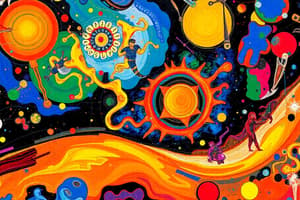Podcast
Questions and Answers
The study of Evolutionary Biology exclusively examines only the flora on Earth.
The study of Evolutionary Biology exclusively examines only the flora on Earth.
False (B)
Stellar distances can be measured in light years, indicating time taken for light to travel.
Stellar distances can be measured in light years, indicating time taken for light to travel.
True (A)
When observing the stars, we see events that occurred only moments before, as they are close to us.
When observing the stars, we see events that occurred only moments before, as they are close to us.
False (B)
The origin of life and the evolution of the universe are unrelated topics in evolutionary biology.
The origin of life and the evolution of the universe are unrelated topics in evolutionary biology.
Objects in our immediate surroundings can be inferred to have traveled trillions of kilometers to reach us.
Objects in our immediate surroundings can be inferred to have traveled trillions of kilometers to reach us.
Stellar distances are measured in kilometers.
Stellar distances are measured in kilometers.
Evolutionary Biology examines the changes in flora and fauna over time.
Evolutionary Biology examines the changes in flora and fauna over time.
Objects around us can be seen at the same time they exist.
Objects around us can be seen at the same time they exist.
The origin of life and the evolution of the universe are unrelated topics.
The origin of life and the evolution of the universe are unrelated topics.
We can see stars as they are today because light from them travels instantly.
We can see stars as they are today because light from them travels instantly.
Flashcards are hidden until you start studying
Study Notes
Evolutionary Biology
- Evolutionary Biology examines changes in living organisms on Earth over time.
- Understanding the origin of life requires context on the universe's beginnings.
Origin of Life
- Observing stars allows us to look back in time; stellar distances are measured in light years.
- The universe is vast, containing objects whose light has traveled millions of years to reach us.
- The Earth is about 4.5 billion years old and part of the Milky Way galaxy.
- Early Earth had a dense atmosphere composed of water vapor, methane, carbon dioxide, and ammonia.
- As the Earth cooled, water vapor condensed to form oceans.
Theories on the Origin of Life
-
Origin in Outer Space:
- Suggests life on Earth may have been transferred from other planets around 4 billion years ago.
-
Theory of Spontaneous Generation:
- Early belief held that life arose from decaying matter.
- Louis Pasteur disproved this, demonstrating that new life only comes from existing life, not spontaneously from non-living substances.
-
Theory of Chemical Evolution:
- Proposed by scientists like Oparin and Haldane, this theory suggests life started from non-living organic molecules.
- Early Earth conditions included high temperatures, volcanic activity, and a reducing atmosphere containing methane (CH4) and ammonia (NH3).
- In 1953, S.L. Miller simulated these conditions, leading to the formation of amino acids, sugars, and organic molecules in his experiments, supporting the idea of chemical evolution.
Studying That Suits You
Use AI to generate personalized quizzes and flashcards to suit your learning preferences.




